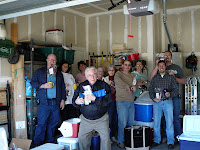 I'm a meal planner and for years have relied on knowing that no matter what ingredients a recipe called for I could just pop down to the supermarket and pick it up. Didn't matter where it came from or how it tasted, only that I had it. A couple of years ago we made a concerted effort to changed our approach to life from a mentality that asks “What do I want?” to one that asks “What do I have?” This question is particularly life-changing when it comes to food and meal planning so in 2007 we started purchasing all our produce through local farmers markets and CSA’s. This posed something of a dilemma when it was time to plan weekend dinners and parties. I needed to know, at least approximately, what we could buy at the farmers market throughout the season. So we spent the 2007 FM season tracking what could be had.
I'm a meal planner and for years have relied on knowing that no matter what ingredients a recipe called for I could just pop down to the supermarket and pick it up. Didn't matter where it came from or how it tasted, only that I had it. A couple of years ago we made a concerted effort to changed our approach to life from a mentality that asks “What do I want?” to one that asks “What do I have?” This question is particularly life-changing when it comes to food and meal planning so in 2007 we started purchasing all our produce through local farmers markets and CSA’s. This posed something of a dilemma when it was time to plan weekend dinners and parties. I needed to know, at least approximately, what we could buy at the farmers market throughout the season. So we spent the 2007 FM season tracking what could be had.Last winter I started compiling a list of all the veggies that might be out there, relying heavily on Chez Panisse Vegetables (excellent resource and cookbook for FM shoppers) and online wandering. Then, beginning in June, we’d visit the farmers markets and note what was in the stalls that day. We tracked only fruits and veggies; you can find nuts and homestead cheese, even popcorn, but I was interested only in the fruits and veggies because these items are the things we most often plan to shop for. The RESULTS are in no way scientific or comprehensive (sometimes we missed a day), but they could be helpful and are certainly interesting. We learned a lot about what we can expect seasonally, what is readily available, we discovered rare treats, and met a lot of great people! We’ll be using this information to plan our 2008 food garden around herbs, fruits and veggies we can’t get at the FM. Happy perusing!























